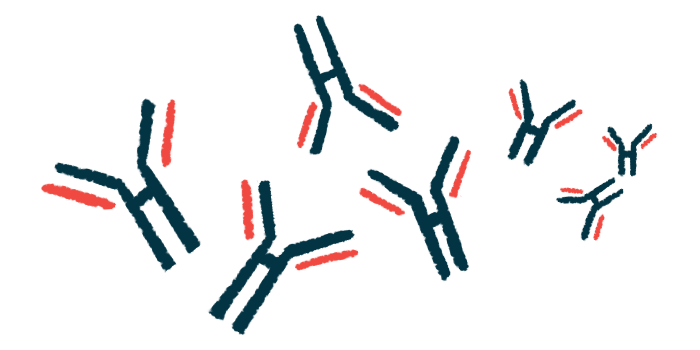Antibodies against HMGB1 and moesin may be useful biomarkers
Study finds higher levels of these self-reactive antibodies in AAV patients

Two types of self-reactive antibodies, called anti-HMGB1 and anti-moesin antibodies, are present at significantly higher levels in the blood of ANCA-associated vasculitis (AAV) patients relative to healthy people and those with other autoimmune diseases, a study shows.
The levels of these antibodies are also linked to how AAV manifested in the body or how it responded to treatment.
Together, these findings suggest that antibodies against HMGB1 or moesin may serve as biomarkers to help diagnose AAV and make a prognosis of the disease.
The study, “The role of anti-HMGB1 antibody and anti-moesin antibody in ANCA-associated vasculitis,” was published in the journal Medicina Clínica.
Study set out to find other self-reactive antibodies that may drive AAV
AAV is an autoimmune disease that occurs when self-reactive antibodies known as ANCAs wrongly activate neutrophils, a type of immune cell, causing inflammation and damage to small blood vessels, most commonly those in the kidneys and lungs.
ANCAs target mostly MPO and PR3, two proteins in neutrophils. However, other self-reactive antibodies may play a role in how AAV develops and progresses. That’s the case of ANCAs against HMGB1, a protein found inside neutrophils, and self-reactive antibodies against moesin, a protein found on the surface of neutrophils.
To better understand whether these antibodies can be used to diagnose AAV or to predict disease manifestations or treatment response, a team of researchers in China measured the blood antibody levels in AAV patients, people with other autoimmune diseases, and healthy people.
The AAV group comprised 60 patients (42 women and 18 men) with a mean age of 66 years. Most (86.7%) had anti-MPO ANCAs; five (8.3%) had anti-PR3 ANCAs; and the remaining three (5%) tested negative for both of these ANCAs. Three-quarters of patients (76.7%) had lung involvement, while more than half (58.3%) had kidney involvement.
The control groups included 58 people with autoimmune diseases other than AAV and 50 healthy people, ages 30-75 years.
Anti-HMGB1 and anti-moesin antibodies play important roles in the diagnosis and prognosis of AAV.
Results showed that the blood levels of both anti-HMGB1 and anti-moesin antibodies were significantly higher in people with AAV than in those with another autoimmune disease or in healthy controls.
Using an anti-HMGB1 antibody cut-off value of 149.22 nanograms per milliliter (ng/mL), the researchers could discriminate AAV patients with 95% sensitivity and 97.2% specificity. A test’s sensitivity is its ability to correctly identify those with a given disease, while specificity refers to correctly identifying those without it.
The levels of anti-moesin antibodies, with a cut-off value of 363.34 ng/mL, were not as effective at distinguishing AAV patients, with the test showing lower sensitivity (91.7%) and specificity (52.8%).
These data suggested that anti-HMGB1 ANCAs may be a better diagnostic biomarker for AAV than anti-moesin antibodies.
Also, the median levels of anti-HMGB1 antibodies were more than twice as high in AAV patients with lung involvement than in those without it — a statistically significant difference.
Blood levels of anti-moesin and anti-MPO antibodies were significantly higher, and those of anti-PR3 antibodies were significantly lower, in AAV patients with kidney involvement than in those without.
The higher the levels of anti-moesin antibodies, the more active the disease, as measured using the Birmingham Vasculitis Activity Score, and the higher the creatine levels, a marker of kidney damage.
Anti-HMGB1 antibodies were reduced 3 months after patients started treatment
Nine AAV patients, all newly-diagnosed and positive for anti-MPO ANCAs, received treatment with corticosteroids and monthly into-the-vein cyclophosphamide, an immunosuppressant.
In these patients, blood levels of anti-HMGB1 antibodies were significantly reduced three months after the start of treatment.
This “indicated that anti-HMGB1 antibody levels could reflect therapeutic effect [in] AAV to some extent,” the researchers wrote. They noted, however, that due to the small number of patients in this analysis, larger studies are needed to confirm these findings.
Overall, these findings highlight that “circulating levels of anti-moesin antibody might reflect [kidney] involvement and disease activity of AAV, while anti-HMGB1 antibody levels correlated with [lung] involvement and therapeutic effect of AAV,” the team wrote.
“Anti-HMGB1 and anti-moesin antibodies play important roles in the diagnosis and prognosis of AAV,” the researchers concluded, adding that these “may act as potential disease markers for AAV.”








